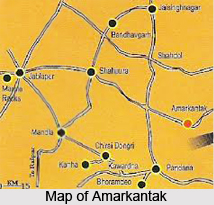Steeped in myths the history of Amarkantak is a tale of valour, camaraderie and severe struggle and religious stability and the associated tales. Amarkantak is a Sanskrit word with much mythological significance, which gains it the prestigious sobriquet as Theertharaja.
Holiness of Amarkantak is greatly associated with the holy river Narmada. Perhaps it is due to the presence of this holy river that this locale in the Vindhyas gets much popularity as a devout centre. As per the Holy Scriptures, River Narmada transcends all other sacred rivers with her indomitable virtue as the daughter of Lord Shiva. Legends has it that a mere glance of this beloved daughter of the destroyer God would fetch innumerable boons and the devotees strongly believe that who ever dies at Amarkantak would fetch salvation.
A land with a vivid history, Amarkantak narrates the tales of various dynasties, right from the Pandavas to the foreign rule of the modern times. Due to occupation of this area by Mandhata the descendants of King Yayati moved from this area to west of Madhya Pradesh and settled on the banks of Narmada River.
According to tradition, this Vindhyachal area was included in the Kingdom of Ayodhya, Kapila Muni, Bhrigu Rishi and Markandeya Rishi had ashrams here. It is also said that Pandavas stayed here and gained spiritual benefits during their exile. Each edifice in Amarkantak portrays diverse styles that recount the period during which these architectural grandeurs were materialized. This stunning facade of Amarkantak gently adds the magnificence of this legendary spot to a great extent.
 Amarkantak in addition to waterways that necessarily do not find their mention in the Indian Vedas have their clear-cut mention in the Puranas, Ramayana, Mahabharata, Vashishtha samhita in addition to "Shatapatha Brahmana". Immediately after Mahabharata becomes a history of a period of concerning 3000 many years is dim Mentor Arjun Chaube Kashyap wraps up how the Puranic name associated with Amarkantak had earlier been "Riskh Parvat". Concerning 6000 many years back again the particular Suryavanshi Samrat Mandhata set up a new village inside the valley Riksh Parvat in addition to referred to as that Mandhata. The actual full story associated with samrat Purukutsa, who was son associated with Mandhata, afforded the particular title associated with Narmada for the pond. Mandhata the particular descendants associated with Yayati shifted out of this region to west associated with Madhya Pradesh in addition to setting up their abode around the banking companies associated with Narmada Water.
Amarkantak in addition to waterways that necessarily do not find their mention in the Indian Vedas have their clear-cut mention in the Puranas, Ramayana, Mahabharata, Vashishtha samhita in addition to "Shatapatha Brahmana". Immediately after Mahabharata becomes a history of a period of concerning 3000 many years is dim Mentor Arjun Chaube Kashyap wraps up how the Puranic name associated with Amarkantak had earlier been "Riskh Parvat". Concerning 6000 many years back again the particular Suryavanshi Samrat Mandhata set up a new village inside the valley Riksh Parvat in addition to referred to as that Mandhata. The actual full story associated with samrat Purukutsa, who was son associated with Mandhata, afforded the particular title associated with Narmada for the pond. Mandhata the particular descendants associated with Yayati shifted out of this region to west associated with Madhya Pradesh in addition to setting up their abode around the banking companies associated with Narmada Water.
The Vindhyachal region had been the abode of mythical allusions as they were intermittently associated with Ayodhya, Kapila Muni, Bhrigu Rishi in addition to Markandeya Rishi who even got ashrams his right here. It`s also explained which Pandavas spent the night`s right here in addition to the accumulated non secular benefits during their exile.
Almost 3000 years of Mahabharata have passed when the great sage and litterateur Adi Shankaracharya was born in 788 AD and consecrated on the banks of Narmada River. It was his enlightened vision that led to the establishment of Pataleshwar Mahadeva in Amarkantak at the origin of Narmada River from the bamboo clumps. Currently this region is known as Surajkund today. There are no bamboo clumps now. However in the more recent history, this area was given in dowry to the Kalachuri King by the Chedi King (10th to 11th century AD).
Kalchuri Maharaja Karnadeva (1042-1072 AD) had constructed temples at Surajkund. In 1808 Amarkantak was ruled by the King of Nagpur and later came under foreign rule. More recently, Amarkantak has been selected by the UPA government as the place for India`s first tribal university.






